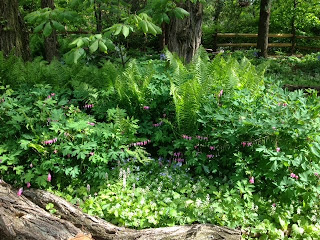 My yard is full of ostrich ferns: tall, elegant, a sturdy
green presence, shading toward brown as winter edges toward us. A friend gave
me one, not too many years ago, and soon I had more. Then more. I dig them up
when they crowd other treasures, move them to dark corners under trees, give
them away. This week I’m moving some to a park, to replace invasive honeysuckle
vines. If you’d like one – let me know. I have plenty to share.
My yard is full of ostrich ferns: tall, elegant, a sturdy
green presence, shading toward brown as winter edges toward us. A friend gave
me one, not too many years ago, and soon I had more. Then more. I dig them up
when they crowd other treasures, move them to dark corners under trees, give
them away. This week I’m moving some to a park, to replace invasive honeysuckle
vines. If you’d like one – let me know. I have plenty to share.
My grandmother was a collector of seeds. At this time of
year, she’d be pocketing things, planning where to grow them. She had flowers
no one else had, from seeds friends gave her over the years: billowing annuals
she grew along the edge of her little trailer home, or planted along the edges
of her tiny yard. When she came to visit us in the first house we owned, an aging twin in
West Philadelphia , she arrived with a small
suitcase in one hand and a bag of twigs in the other, bare root plants for our
first garden. We cleared broken glass from our little urban yard and planted
what she brought: native phlox, lily of the valley, foam flower. They’re still
there in that West Philly yard, lush and green in the alley between the twins.
And I took starts of them with us when we moved to Virginia ,
then again when we moved to our home here in Pennsylvania . The phlox has spread, seeding
around the yard in shades of pink and purple. The foam flower carpets
patches of ground in my woodland garden, blooming in billowing clouds of white. I give bits away,
scatter phlox seed in friends’ meadows. If you need phlox, or foam flower, or lily
of the valley – let me know. I have plenty to share.
Last week I dug an armload of plants to take to a friend’s
home. Her daughter and I planted their first flower garden, with brown-eyed susan,
coreopsis, phlox, perennial geranium. Right now it looks like dirt and sticks,
battered down by October rain. Next spring it will look like something new. By
summer it will be blooming, a bright wash of color along a sagging fence.
As I dig, and plant, and watch the way things spread, it
occurs to me that this is how grace works: we put ourselves in its path, align
ourselves with God’s work in this world, sow our seeds of shalom, and then
watch a mystery far beyond us. I’m not the one who makes plants grow. I have no
control over where the ferns send their runners, little say about where the
phlox seeds land. But I can shepherd the generous growth going on around me,
share it, celebrate it.
Friends who aren’t gardeners are sometimes reluctant to accept
gifts of plants, or seeds. There’s an invisible wall. My space, your space. If
they want plants, they’ll go buy them, thank you. No need for charity here.
What they miss is the joy of the interplay of plants: the
give and take, the sharing of the mystery. Fellow gardeners get it. We walk
each other’s yards, exclaim over unexpected beauty: vines in full bloom,
unusual seed pods, a cotillion of butterflies in a patch of morning sun. We
pause to ask about unfamiliar plants, to note how things spread, to offer
additions. “Let me dig you a start of this!” “I’ll give you a cutting. Just
stick it in the ground and it will grow.”
My friend shows up at our birdwalks some weeks with
odds and ends she’s dug from her yard. She likes explaining them. Cardinal
flower. Blue lobelia. A baby juniper that seeded in her yard. I’ve promised her
a start of my symphoricarpus orbiculatus – native coralberry. I have it growing
in the shade, where it spreads by runners, looking for the sun. I need to start
moving it to other places – the park, Sarah’s yard, a sunnier spot in my own.
Again – if you want some? Let me know.
I have friends who say they don’t need grace. Don’t want it.
Can live without it. God is a crutch. His love an illusion. My space, your
space. If I need something I’ll get it myself. No need for charity. I’m fine on
my own.
Maybe.
Entomologist Doug Tallamy, brilliant bug man at the University of Delaware
 |
| C Judd Patterson, 2008, Backyards for Nature: Fireflies |
And billows up in new life: tree seedlings, unexpected
vines, spreading groundcovers, butterflies.
My neighbor mentioned that he and his daughter sit on their
deck and watch the fireflies in our trees. They have some in their yard, now
and then. But our trees are full of them. His daughter thinks it’s magic.
Fireflies, like many other native creatures, are
disappearing due to habitat loss. They can’t survive in well manicured yards.
They need fallen logs, leaf piles, lots of native trees and shrubs.
It’s possible to live a self-enclosed, self-motivated life,
with nicely delineated borders, carefully manicured edges.
For a while.
As a culture we’re exploring that option: lives lived in
reference only to ourselves. Neatly packaged food from well stocked superstores. Entertainment on individual
screens. Personal cars parked in personal driveways. My space, your space. No
need for grace.
The dead zones keep growing. In our bays, choked by the
nitrogen runoff from our perfectly green lawns. In our cities, struggling under
the weight of our self-referential neglect.
In our firefly-free yards. In our fractured families. In our carefully guarded hearts.
But God’s generative grace is just a heart-turn away. Like
the rain, that can run off to flood our streams and spillways, or soak in
slowly around ferns, moss, willows.
Like the sun, scorching the chemical-laden turf, or smiling
through the layers of locust, dogwood, fern.
Like the spread of sundrops, phlox, and foam flower:
someone else’s sticks and weeds, in someone else’s yard. Or gifts of grace to be given,
received, shared, swapped, enjoyed.
It’s the perfect time to be moving plants: cool, wet, still
warm enough for roots to settle in.
It’s also time for harvesting seed: aster, ironweed,
goldenrod, rudbeckia.
And time, as well, for slowing down enough to think: how
does grace flow from my life to others? How does generosity spill from me, to
you, my yard to yours, my heart to yours, your heart to mine?
Need some coralberries? Phlox seed? Time? Prayer?
Let me know. Some days - by God's generative grace - I have plenty to share.
As always, your thoughts, comments, questions are welcome.
Whoever sows sparingly will also reap sparingly, and whoever sows generously will also reap generously. . . Now he who supplies seed to the sower and bread for food will also supply and increase your store of seed and will enlarge the harvest of your righteousness. You will be enriched in every way so that you can be generous on every occasion, and through us your generosity will result in thanksgiving to God.
This post is part of an ongoing series on God's Green Equity.
- God's Green Equity: August 4, 2013
- Seed Parables: August 11, 2013
- Miracle Seeds of Sorrow's Kingdom: August 25, 2013
- How Much Does Justice Cost? September 1, 2013
- Taxonomy of Ignorance and the Unknown Unknowns: September 8,2013
- For God so Loved the Earth, September 15, 2013
- Reflections and Refractions on the Anacotia River, Sept. 22, 2013
- Imagining Wholeness, Sept. 29, 2013
- Summoned toward Wholeness, Oct. 6, 2013
Earlier posts on the same topic:
- Green Grace: May 15, 2011
- Earth Day Shalom: April 22, 2012
- Hungering Far Past Rightness: March 3, 2013

